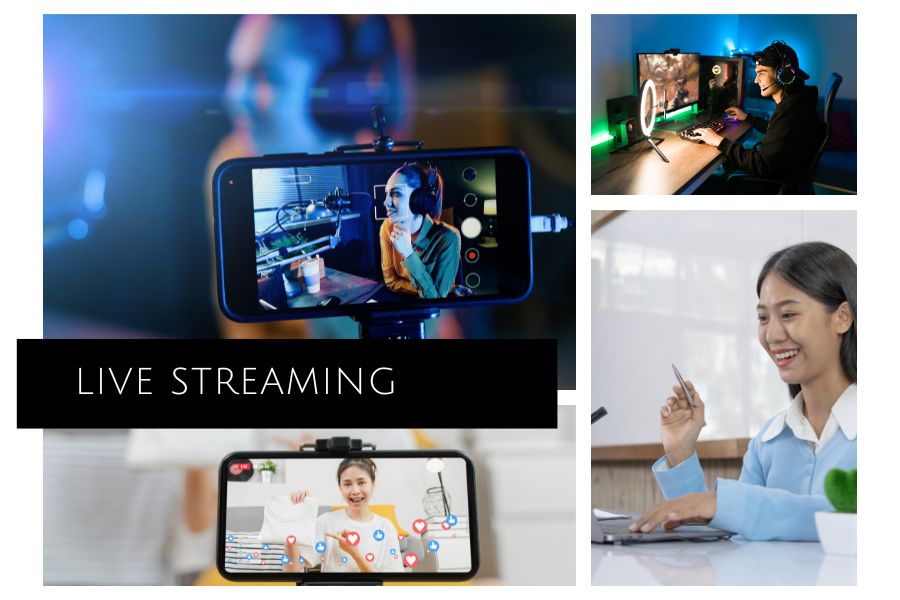Table of Content
1. Introduction to Live Streaming
2. Importance of Live Streaming in Modern Business
3. Understanding the Power of Live Streaming Platforms
4. Tips for Successful Live Streaming
5. Leveraging Live Streaming for Marketing
6. Measuring Success: Analytics and Metrics
7. Challenges and Solutions in Live Streaming
8. Future Trends in Live Streaming Technology
9 Conclusion
Live streaming has revolutionized the way businesses interact with their audiences. With the rise of digital media, live-streaming has emerged as a powerful tool for engaging with customers, launching products, and creating unforgettable experiences. In this comprehensive blog, we’ll explore how live streaming can elevate your brand’s success and why it has become an essential component of modern business strategies.
Introduction to Live Streaming
Live streaming involves broadcasting real-time video content over the internet. Unlike pre-recorded videos, live streams enable immediate interaction between broadcasters and viewers, fostering a sense of authenticity and connection.
Example: Imagine you are a fashion retailer planning to unveil your latest collection. Instead of releasing a pre-recorded video, you decide to live stream the fashion show on your website. Viewers can watch the models strut down the runway in real-time and engage with the designers through live chat, creating an immersive and interactive experience.
Importance of Live Streaming in Modern Business

Enhancing Engagement: Live streaming captivates audiences by offering dynamic and interactive content. Viewers can participate in live chats, ask questions, and provide feedback in real-time, creating a sense of community around your brand.
Boosting Product Launches: Live-streaming provides a platform for unveiling new products or services to a global audience. By broadcasting live product launches, businesses can generate excitement, build anticipation, and drive sales.
Creating Memorable Experiences: Live streaming allows businesses to showcase their culture, values, and personality in a way that resonates with viewers. Whether hosting virtual events, behind-the-scenes tours, or interactive workshops, live streams offer unique opportunities to engage and connect with customers on a deeper level.
Example: A tech company launching a new smartphone organizes a live event where viewers can see the features demonstrated in real-time, ask questions to the engineers and designers, and even participate in a live giveaway of the product.
Understanding the Power of Live Streaming Platforms
Overview of Platforms: There are numerous live streaming platforms available, each with its own features and audience demographics. Popular platforms include YouTube Live, Instagram Live, Facebook Live, Twitch, and LinkedIn Live.
Choosing the Right Platform for Your Needs: When selecting a live streaming platform, consider factors such as your target audience, content format, and desired features. Choose a platform that aligns with your brand identity and objectives to maximize reach and engagement.
Example: A fitness influencer decides to host live workout sessions. After researching different platforms, they choose Instagram Live for its strong community of health-conscious users and easy-to-use interface.
Tips for Successful Live Streaming

Planning Your Content: Before going live, plan your content carefully to ensure it aligns with your brand messaging and resonates with your audience. Create an outline or script, prepare visual aids or demonstrations, and rehearse your presentation to maintain professionalism and coherence during the stream.
Engaging with Your Audience: Engagement is key to a successful live stream. Encourage viewers to interact by asking questions, conducting polls, or inviting them to share their thoughts and experiences. Respond to comments and feedback in real-time to foster a sense of connection and community.
Technical Considerations: Ensure a smooth and professional live streaming experience by addressing technical considerations such as internet connection, audiovisual quality, and lighting. Test your equipment beforehand and have backup plans in place to mitigate any technical issues that may arise during the broadcast.
Example: A cooking enthusiast plans a live stream where they demonstrate a new recipe. They prepare all the ingredients in advance, interact with viewers by answering questions about cooking techniques, and ensure proper lighting and camera angles for clear visibility of the cooking process.
Leveraging Live Streaming for Marketing
Promoting Products and Services: Live streaming offers a powerful platform for showcasing products and services in action. Host live demonstrations, product tutorials, or exclusive previews to generate excitement and drive sales.
Hosting Q&A Sessions: Engage with your audience directly by hosting live Q&A sessions. Address common questions, provide valuable insights, and demonstrate expertise in your industry to build trust and credibility with your audience.
Behind-the-Scenes Sneak Peeks: Give viewers an exclusive behind-the-scenes look at your business operations, events, or creative process. Humanize your brand by sharing authentic moments and stories that resonate with your audience on a personal level.
Example: A beauty brand launches a new skincare line and decides to live stream a behind-the-scenes tour of their manufacturing facility, showing viewers how the products are made and sharing experiences into their obligation to quality and supportability.
Measuring Success: Analytics and Metrics
Track key performance indicators (KPIs) such as viewership, engagement, and conversion rates to evaluate the effectiveness of your live streaming efforts. Use analytics tools and audience feedback to refine your strategy and optimize future broadcasts.
Example: Track key performance indicators (KPIs) such as viewership, engagement, and conversion rates to evaluate the effectiveness of your live streaming efforts. Use analytics tools and audience feedback to refine your strategy and optimize future broadcasts. For instance, a live stream for a cooking class might measure success by the number of participants who join the live session and the subsequent increase in sales of related cooking products.
Challenges and Solutions in Live Streaming
While live streaming offers numerous benefits, it also presents unique challenges such as technical issues, audience engagement, and content quality. Identify potential obstacles and develop strategies to overcome them, ensuring a seamless and impactful live-streaming experience.
Example: While live streaming offers numerous benefits, it also presents unique challenges such as technical issues, audience engagement, and content quality. Identify potential obstacles and develop strategies to overcome them, ensuring a seamless and impactful live-streaming experience. For example, having a dedicated technical team to troubleshoot issues during a live event can mitigate interruptions and ensure a smooth viewing experience for the audience.
Future Trends in Live Streaming Technology

Stay ahead of the curve by exploring emerging trends and innovations in live-streaming technology. From virtual reality (VR) experiences to interactive storytelling, the future of live streaming holds limitless possibilities for businesses seeking to engage and inspire their audiences.
Example: Stay ahead of the curve by exploring emerging trends and innovations in live streaming technology. From virtual reality (VR) experiences to interactive storytelling, the future of live streaming holds limitless possibilities for businesses seeking to engage and inspire their audiences. For example, integrating augmented reality (AR) filters into live streams can enhance viewer engagement by allowing them to interact with the content in real-time.
Conclusion
In conclusion, live streaming has become an indispensable tool for businesses looking to connect with their audience, launch products, and create memorable experiences. By utilizing the force of live-streaming stages and executing best practices for content creation and commitment, organizations can open new open doors for development and outcome in the advanced age.
What is Live Streaming Technology, and How Does it Work? Read More.
Unique FAQs
1. How can I ensure a successful live-streaming experience for my business?
Focus on planning, engagement, and technical readiness to deliver a seamless and impactful live stream.
2. Which live streaming platform is best for my business?
Choose a platform that aligns with your target audience, content format, and marketing objectives.
3. What are some common challenges in live streaming, and how can I overcome them?
Technical issues, audience engagement, and content quality are common challenges that can be addressed through proper planning, preparation, and problem-solving strategies.
4. How can I measure the success of my live-streaming efforts?
Track key performance indicators such as viewership, engagement, and conversion rates using analytics tools and audience feedback.
5. What are some emerging trends in live-streaming technology to watch out for?
Keep an eye on developments in virtual reality (VR), augmented reality (AR), and interactive storytelling for future opportunities to enhance your live streaming experiences.

